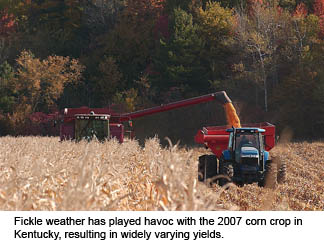State’s Corn Harvest a Mixed Bag
State’s Corn Harvest a Mixed Bag

Farmers are harvesting cornfields at a rapid pace. Thanks to fickle weather that provided adequate, timely rains to some fields while others languished in hot, dry conditions, farmers are seeing mixed results.
With nearly 70 percent of the state’s 2007 corn crop already in the bin, farmers are reporting widely varying yields not only across the state but within regions and even counties. Dry weather conditions have increased dry down of the crop with harvest running well ahead of last year and the five-year average, according to the Kentucky Field Office of the National Agricultural Statistics Service.
Kentucky’s average corn yield is expected to be 120 bushels per acre, well below the 2006 average of 146 bushels per acre. Jim Herbek, grains crop specialist with the University of Kentucky College of Agriculture, said he expects that yield estimate will be close to the final yields, but are not likely to be above that. He’s had reports ranging from as low as 30 bushels per acre to highs above 200 bushels per acre.
“What I’ve been hearing is all over the place, which is a good indication of how the moisture was this summer,” he said. “Even though we had an extended drought in the state, showers came through and some people were able to get them, and some didn’t get any throughout July and August. It shows how important timely showers at certain growth stages can be.”
Reports from several counties in the state reflect this variability. In Logan County, where nearly all the crop has been harvested, yields are averaging 95 to 100 bushels per acre and have ranged from 25 to 260 bushels in one northern field, said Chris Milam, Logan County extension agent for agriculture and natural resources.
In Webster County, the majority of corn has been harvested and has yielded between 60 and 200 bushels per acre with an average yield of 130, said Vicki Shadrick, Webster County extension agent for agriculture and natural resources.
In general, the crop got off to a good, early start this spring and when the drought really hit, much of the corn was far enough along in its development to not be impacted as greatly as it could have been, Herbek said.
“We didn’t have too many pollination problems, so it was just a matter of the drought hurting it in the grain fill stages,” he said.
This year’s corn crop will be larger than last year’s because of increased acres. Kentucky farmers planted 1.34 million acres, an increase of 300,000. With the increased acres, the crop will be the largest in 21 years, according to the statistical reporting service. Farmers upped their corn acres because of high demand, especially from ethanol production.
